自身耐受和免疫异常与免疫介导的炎症性疾病
医学免疫学名词解释+简答题(参照人卫完整)

医学免疫学名词解释+简答题(参照人卫完整)第一章名词解释:医学免疫学是研究人体免疫系统结构和功能的科学。
该学科的重点在于阐述该系统识别抗原和危险信号后发生免疫应答和清除抗原的规律,探讨免疫功能缺陷所致疾病及其发生机制,为这些疾病的诊断、预防和治疗提供理论基础和技术方法。
免疫防御是防止外界病原体的入侵和清除已入侵病原体,如细菌、真菌、病毒、支原体、衣原体和寄生虫等。
若免疫防御功能缺陷或缺失,会引起免疫缺陷病;若应答过强,则在清除病原体的同时,也会导致组织损伤和功能异常,如发生超敏反应疾病等。
免疫监视是随时发现和清除体内出现的“非己”成分,如基因突变形成的肿瘤细胞,坏死或衰老细胞。
若免疫监视功能低下,可能会导致肿瘤的发生。
免疫自稳是通过自身免疫耐受和免疫调节两种主要机制维持机体内环境的稳定。
一般情况下,机体不会对自身组织和细胞发生免疫应答,这称为自身免疫耐受。
这赋予了机体识别自身和非己的能力。
如果自身免疫耐受被打破,免疫调节紊乱,则会导致自身免疫疾病和过敏性疾病。
免疫应答是指免疫系统识别和清除“非己”的全过程,可分为固有免疫应答和适应性免疫应答。
问答题:试述免疫系统的功能。
免疫系统的功能是机体识别和清除外来侵入抗原和体内突变、死亡细胞来维持机体内环境稳定。
它包括免疫防御、免疫监视和免疫自稳三个方面。
试比较固有免疫应答和适应性免疫应答。
固有免疫应答是一种非特异性的免疫应答,能够迅速识别和清除病原体,但不能产生免疫记忆。
适应性免疫应答是一种特异性的免疫应答,需要一定时间来识别和清除病原体,但能够产生免疫记忆,从而在再次暴露于同一病原体时更快、更有效地清除它。
第二章名词解释:中枢免疫器官是免疫细胞发生、分化、发育和成熟的场所。
人和其他哺乳类动物的中枢免疫器官包括胸腺和骨髓。
外周免疫器官是成熟淋巴细胞(T细胞和B细胞)定居的场所,也是这些淋巴细胞针对外来抗原刺激启动初次免疫应答的主要场所。
它包括淋巴结、脾和黏膜相关淋巴组织等。
《免疫革命:如何从根本上抵御并逆转自身免疫性疾病》札记
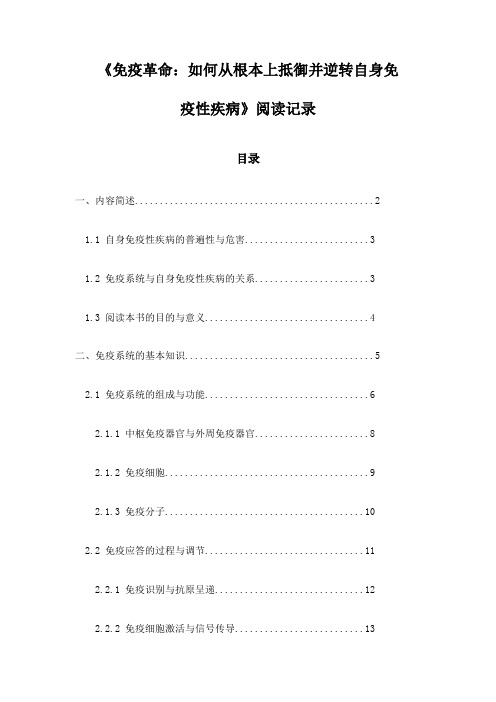
《免疫革命:如何从根本上抵御并逆转自身免疫性疾病》阅读记录目录一、内容简述 (2)1.1 自身免疫性疾病的普遍性与危害 (3)1.2 免疫系统与自身免疫性疾病的关系 (3)1.3 阅读本书的目的与意义 (4)二、免疫系统的基本知识 (5)2.1 免疫系统的组成与功能 (6)2.1.1 中枢免疫器官与外周免疫器官 (8)2.1.2 免疫细胞 (9)2.1.3 免疫分子 (10)2.2 免疫应答的过程与调节 (11)2.2.1 免疫识别与抗原呈递 (12)2.2.2 免疫细胞激活与信号传导 (13)2.2.3 免疫应答的调控与终止 (13)三、自身免疫性疾病的发病机制 (15)3.1 免疫耐受的破坏与自身免疫性疾病的启动 (16)3.1.1 免疫系统对自身抗原的免疫忽视与耐受 (16)3.1.2 环境因素与遗传因素对免疫耐受的影响 (18)3.2 免疫细胞的异常活化和自身免疫损伤 (19)3.2.1 T细胞与B细胞的异常活化 (20)3.2.2 细胞因子与趋化因子的作用 (22)3.2.3 炎症反应与组织损伤 (23)四、免疫革命的战略举措 (24)4.1 重塑免疫耐受 (25)4.1.1 调整免疫系统对自身抗原的识别与应答 (27)4.1.2 利用免疫抑制剂与生物制剂进行干预 (28)4.2 激活自我修复机制 (29)4.2.1 促进T细胞与B细胞的平衡与调节 (31)4.2.2 增强免疫细胞的清除功能与组织修复能力 (32)4.3 生活方式的调整与健康管理 (34)4.3.1 健康饮食与营养补充 (35)4.3.2 规律作息与适度运动 (36)4.3.3 心理调适与压力管理 (37)五、结论与展望 (39)5.1 免疫革命的重要性与挑战 (40)5.2 未来研究方向与发展趋势 (41)5.3 个人与社会层面的应对策略 (43)一、内容简述《免疫革命:如何从根本上抵御并逆转自身免疫性疾病》是一本深入探讨免疫系统与自身免疫性疾病关系的书籍。
免疫调节与免疫疾病

免疫调节与免疫疾病免疫系统是人体内的一组高度复杂的生物结构,主要功能是保护机体免受外界病原体的侵害,并维持内部环境的稳定。
这一系统的正常运转对于个体的健康至关重要,而免疫调节和免疫疾病则是与免疫系统密切相关的两个重要概念。
一、免疫调节的概念与作用免疫调节是指机体在面对各种外界因素(如病原体、异物等)时,通过一系列生物化学反应和细胞间的相互作用,来维持免疫系统内的平衡状态。
免疫调节的主要作用包括以下几个方面:1. 免疫系统的激活与抑制:当机体遭受外界侵袭时,免疫系统会被激活,从而产生针对这些外界因素的免疫应答。
这一过程中,免疫调节起到了重要的抑制作用,避免免疫系统过度活跃而导致的自身伤害。
2. 免疫细胞的发育和分化:在免疫调节的过程中,一些细胞会发生分化和成熟,从而增加机体的免疫能力。
例如,T细胞的发育和分化过程中,CD4+ T细胞可以分化为不同的亚群,包括辅助性T细胞和调节性T细胞,它们在免疫调节中起到了重要的作用。
3. 免疫耐受的建立:免疫调节还可以帮助机体建立免疫耐受,即对于自身组织的免疫应答得以抑制。
这一过程对于防止自身免疫疾病的发生是至关重要的。
二、免疫调节的重要调控因子在免疫调节的过程中,存在一系列重要的调控因子,它们通过相互作用来维持免疫系统内的平衡状态。
以下是几个常见的免疫调节因子:1. 细胞因子:细胞因子是一类可以调节免疫细胞功能的小分子蛋白质,包括白细胞介素、干扰素和肿瘤坏死因子等。
它们通过与特定的细胞表面受体结合,来介导免疫细胞间的相互作用和信号传导。
2. 调节性T细胞:调节性T细胞是一种特殊的T细胞亚群,它在免疫调节中起到了重要的作用。
调节性T细胞通过释放抑制性细胞因子,抑制其他免疫细胞的功能,从而避免免疫过度激活。
3. 共刺激分子:共刺激分子是免疫细胞表面的一类分子,它们可以传递刺激信号,调节免疫细胞的活化和功能。
共刺激分子的不平衡可能导致免疫疾病的发生。
三、免疫疾病的发生与机制免疫疾病是指机体免疫系统异常地攻击自身组织,引发一系列病理改变和炎症反应。
自身抗体的应用及研究进展
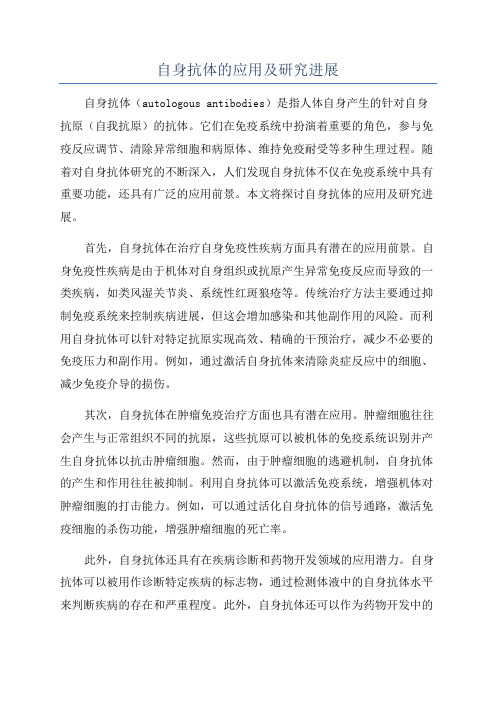
自身抗体的应用及研究进展自身抗体(autologous antibodies)是指人体自身产生的针对自身抗原(自我抗原)的抗体。
它们在免疫系统中扮演着重要的角色,参与免疫反应调节、清除异常细胞和病原体、维持免疫耐受等多种生理过程。
随着对自身抗体研究的不断深入,人们发现自身抗体不仅在免疫系统中具有重要功能,还具有广泛的应用前景。
本文将探讨自身抗体的应用及研究进展。
首先,自身抗体在治疗自身免疫性疾病方面具有潜在的应用前景。
自身免疫性疾病是由于机体对自身组织或抗原产生异常免疫反应而导致的一类疾病,如类风湿关节炎、系统性红斑狼疮等。
传统治疗方法主要通过抑制免疫系统来控制疾病进展,但这会增加感染和其他副作用的风险。
而利用自身抗体可以针对特定抗原实现高效、精确的干预治疗,减少不必要的免疫压力和副作用。
例如,通过激活自身抗体来清除炎症反应中的细胞、减少免疫介导的损伤。
其次,自身抗体在肿瘤免疫治疗方面也具有潜在应用。
肿瘤细胞往往会产生与正常组织不同的抗原,这些抗原可以被机体的免疫系统识别并产生自身抗体以抗击肿瘤细胞。
然而,由于肿瘤细胞的逃避机制,自身抗体的产生和作用往往被抑制。
利用自身抗体可以激活免疫系统,增强机体对肿瘤细胞的打击能力。
例如,可以通过活化自身抗体的信号通路,激活免疫细胞的杀伤功能,增强肿瘤细胞的死亡率。
此外,自身抗体还具有在疾病诊断和药物开发领域的应用潜力。
自身抗体可以被用作诊断特定疾病的标志物,通过检测体液中的自身抗体水平来判断疾病的存在和严重程度。
此外,自身抗体还可以作为药物开发中的靶点。
通过研究自身抗体的功能和作用机制,可以开发出针对自身抗体的抗体药物,用于治疗相关疾病。
需要指出的是,自身抗体的应用及研究还存在一些挑战和限制。
首先,由于自身抗体产生过程的复杂性和多样性,研究自身抗体的技术和方法也面临一定的困难。
其次,自身抗体在临床应用中可能会产生免疫相关的不良反应,因此需要更深入的研究和实验来验证其有效性和安全性。
中国免疫性皮肤病研究进展

中国免疫性皮肤病研究进展蒋娇 陆前进 (中国医学科学院皮肤病医院,南京 210042)中图分类号 R392 文献标志码 A 文章编号 1000-484X (2024)01-0037-15[摘要] 免疫性皮肤病指一类免疫系统介导的自身免疫性或炎症性皮肤病,包括红斑狼疮、银屑病、特应性皮炎和白癜风等。
免疫性皮肤病发病机制仍不明确,疾病进程复杂,临床表现多样,治疗困难,给免疫性皮肤病的诊断和治疗带来了巨大挑战。
近年来,我国皮肤病学研究者在免疫性皮肤病方面取得了许多创新性研究成果。
近10年中国学者在免疫性皮肤病领域发表SCI 论文11 919篇,其中10余篇发表在顶级期刊,包括发表在科学(Science ) 1篇、自然(Nature ) 1篇、细胞(Cell ) 2篇、新英格兰医学杂志(New England Journal of Medicine ) 3篇、柳叶刀(The Lancet ) 2篇、自然医学(Nature Medicine ) 1篇及免疫 (Immunity ) 4篇等。
本文主要就我国在免疫性皮肤病发病机制、诊断及治疗方式等方面的研究进展进行总结。
[关键词] 免疫性皮肤病;红斑狼疮;银屑病;特应性皮炎;白癜风Research progress on immunologic skin diseases in ChinaJIANG Jiao , LU Qianjin. Hospital for Skin Diseases , Institute of Dermatology , Chinese Academy of Medical Sciences & Peking Union Medical College , Nanjing 210042, China[Abstract ] Immunologic skin diseases encompass a spectrum of immune system -mediated autoimmune or inflammatory skin conditions , such as lupus erythematosus , psoriasis , atopic dermatitis , and vitiligo. Immunologic skin diseases are characterized by an unclear pathogenesis , complex disease processes , diverse clinical manifestations , and treatment difficulties , thereby presenting sig‐nificant diagnostic and therapeutic challenges. Notably , Chinese researchers have achieved numerous innovative research findings on immunologic skin diseases in recent years. Over the past decade , Chinese scholars have contributed 11 919 SCI papers to the field of immune dermatosis , with more than 10 being published in the world's leading medical journals. These publications include one in Sci⁃ence , one in Nature , two in Cell , three in The New England Journal of Medicine , two in The Lancet , and one in Nature Medicine , as well as four in Immunity . Here , we aim to present a comprehensive summary of Chinese research progress pertaining to the pathogene‐sis , diagnosis and treatment of immunologic skin diseases.[Key words ] Immunologic skin diseases ;Lupus erythematosus ;Psoriasis ;Atopic dermatitis ;Vitiligodoi :10.3969/j.issn.1000-484X.2024.01.005基金项目:国家科技重大专项(2020ZX09201-28);中国医学科学院医学与健康科技创新工程(CIFMS )(2019-2M -5-033)。
炎症是否与自身免疫性疾病有关?

炎症是否与自身免疫性疾病有关?导论:自身免疫性疾病与炎症一直是医学界关注的热点问题。
然而,将炎症与自身免疫性疾病联系起来并不总是正确的。
本文将以科学的角度探讨炎症与自身免疫性疾病之间的关系,以更好地理解这个问题。
一、炎症与自身免疫性疾病的本质关系炎症是机体免疫系统对损伤或感染的一种非特异性防御反应。
自身免疫性疾病则是机体免疫系统对自身组织误认为外来入侵物质,产生异常免疫反应。
虽然两者都与机体的免疫系统有关,但其本质的差异使得炎症并非自身免疫性疾病的直接原因。
二、炎症在自身免疫性疾病中的角色尽管炎症不是自身免疫性疾病的根本原因,但在其发展过程中扮演着重要角色。
在自身免疫性疾病发展的初期,炎症反应可能作为一种早期的免疫应答,使机体警觉到潜在的异常免疫反应。
然而,随着炎症的持续存在,可能会导致损伤正常组织,加剧自身免疫性疾病的病情。
因此,炎症在自身免疫性疾病的发展中扮演着复杂而重要的角色。
三、免疫耐受失调与炎症免疫耐受失调是导致自身免疫性疾病的一个重要因素。
研究表明,炎症可能在免疫耐受失调的形成和维持中起到关键作用。
炎症诱导的免疫细胞活化和趋化因子的释放,可能导致免疫耐受机制的破坏,从而加剧自身免疫性疾病的病情。
了解免疫耐受失调与炎症的关系有助于我们更好地阻断自身免疫性疾病的发展。
四、炎症抑制治疗在自身免疫性疾病的应用针对炎症在自身免疫性疾病的作用,抑制炎症反应成为了一种重要的治疗策略。
通过抑制炎症反应可以减轻自身免疫性疾病患者的病情,并帮助控制疾病的进展。
然而,必须注意到炎症在机体的免疫防御中的重要作用,不正确的抑制炎症反应可能导致免疫功能下降,增加感染等风险。
因此,在治疗过程中需要综合考虑个体情况,合理使用炎症抑制治疗。
结语:炎症与自身免疫性疾病之间的关系复杂而多样。
我们应该根据科学的证据来准确理解其本质,并在临床实践中合理应用炎症抑制治疗。
进一步的研究和探索将有助于我们深入了解自身免疫性疾病的发病机制,并为寻找更有效的治疗方法提供理论基础。
超敏反应的四个类型详解
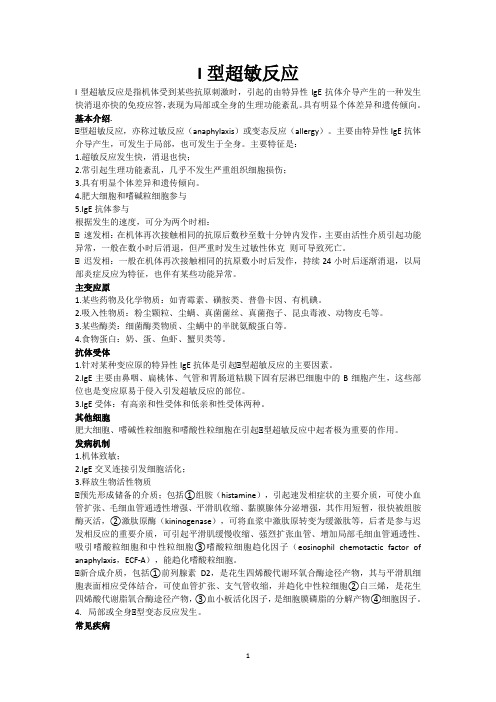
I型超敏反应I型超敏反应是指机体受到某些抗原刺激时,引起的由特异性IgE抗体介导产生的一种发生快消退亦快的免疫应答,表现为局部或全身的生理功能紊乱。
具有明显个体差异和遗传倾向。
基本介绍.Ⅰ型超敏反应,亦称过敏反应(anaphylaxis)或变态反应(allergy)。
主要由特异性IgE抗体介导产生,可发生于局部,也可发生于全身。
主要特征是:1.超敏反应发生快,消退也快;2.常引起生理功能紊乱,几乎不发生严重组织细胞损伤;3.具有明显个体差异和遗传倾向。
4.肥大细胞和嗜碱粒细胞参与5.IgE抗体参与根据发生的速度,可分为两个时相:Ⅰ 速发相:在机体再次接触相同的抗原后数秒至数十分钟内发作,主要由活性介质引起功能异常,一般在数小时后消退,但严重时发生过敏性休克则可导致死亡。
Ⅰ 迟发相:一般在机体再次接触相同的抗原数小时后发作,持续24小时后逐渐消退,以局部炎症反应为特征,也伴有某些功能异常。
主变应原1.某些药物及化学物质:如青霉素、磺胺类、普鲁卡因、有机碘。
2.吸入性物质:粉尘颗粒、尘螨、真菌菌丝、真菌孢子、昆虫毒液、动物皮毛等。
3.某些酶类:细菌酶类物质、尘螨中的半胱氨酸蛋白等。
4.食物蛋白:奶、蛋、鱼虾、蟹贝类等。
抗体受体1.针对某种变应原的特异性IgE抗体是引起Ⅰ型超敏反应的主要因素。
2.IgE主要由鼻咽、扁桃体、气管和胃肠道粘膜下固有层淋巴细胞中的B细胞产生,这些部位也是变应原易于侵入引发超敏反应的部位。
3.IgE受体:有高亲和性受体和低亲和性受体两种。
其他细胞肥大细胞、嗜碱性粒细胞和嗜酸性粒细胞在引起Ⅰ型超敏反应中起者极为重要的作用。
发病机制1.机体致敏;2.IgE交叉连接引发细胞活化;3.释放生物活性物质Ⅰ预先形成储备的介质;包括①组胺(histamine),引起速发相症状的主要介质,可使小血管扩张、毛细血管通透性增强、平滑肌收缩、黏膜腺体分泌增强,其作用短暂,很快被组胺酶灭活,②激肽原酶(kininogenase),可将血浆中激肽原转变为缓激肽等,后者是参与迟发相反应的重要介质,可引起平滑肌缓慢收缩、强烈扩张血管、增加局部毛细血管通透性、吸引嗜酸粒细胞和中性粒细胞③嗜酸粒细胞趋化因子(eosinophil chemotactic factor of anaphylaxis,ECF-A),能趋化嗜酸粒细胞。
免疫系统的异常与自身免疫疾病

免疫系统异常导致自身免疫疾病的机制
分子模拟机制
外来抗原与自身抗原在分子结 构上的相似性,导致免疫系统 误将自身抗原当作外来抗原进 行攻击。
免疫调节失衡机制
免疫系统内部调节机制的失衡 ,如Th1/Th2细胞平衡失调, 导致自身免疫反应的发生。
遗传易感性机制
某些基因的多态性与自身免疫 疾病的易感性相关,如HLA基 因等。
这类疾病的特点是免疫系统错误地将自身组织识别为“异己”并 进行攻击,导致炎症反应和组织损伤响全身多个器官和系统,如系统性红斑狼疮、类风湿性关节炎 等。
器官特异性自身免疫疾病
主要影响某一特定器官或组织,如甲状腺自身免疫性疾病(如 Graves病、桥本甲状腺炎)等。
可导致甲状腺肿大、结节、疼痛等症状。
治疗方法包括药物治疗、手术治疗和放射性碘治疗。
03
其他常见自身免疫疾病
强直性脊柱炎
一种主要累及脊柱和骶髂关节 的自身免疫疾病,表现为腰背
痛、晨僵等。
多发性硬化症
一种中枢神经系统脱髓鞘疾病 ,表现为肢体无力、感觉异常 等。
溃疡性结肠炎
一种主要累及结肠和直肠的自 身免疫疾病,表现为腹痛、腹 泻等。
使用免疫抑制剂、抗炎药物等药物,控制病 情发展,缓解症状。
心理支持
提供心理咨询和支持,帮助患者应对疾病带 来的心理压力和焦虑情绪。
未来研究方向与挑战
深入研究自身免疫疾病的发病机制
开发新的治疗方法和药物
进一步揭示自身免疫疾病的发病机制和病 理过程,为开发新的治疗方法和药物提供 理论支持。
针对自身免疫疾病的不同类型和不同阶段 ,开发更加有效和安全的治疗方法和药物 。
适应性免疫
主要由T淋巴细胞和B淋巴细胞 组成,其中T淋巴细胞主要介 导细胞免疫,B淋巴细胞主要 介导体液免疫。
起病隐匿、易漏诊,“自免肝”是什么病?
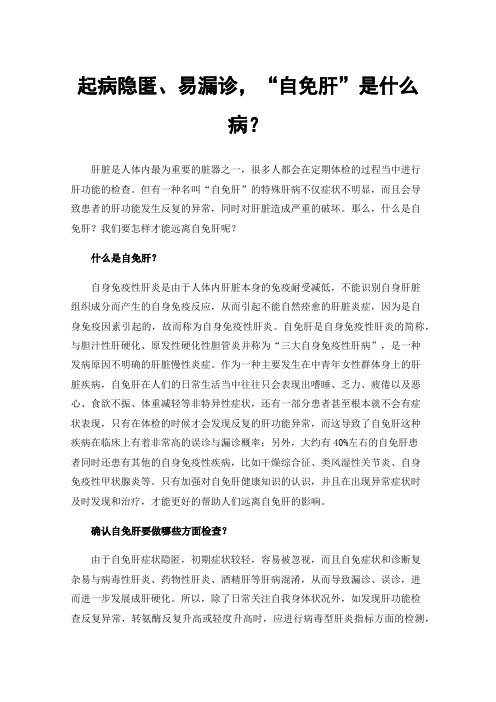
起病隐匿、易漏诊,“自免肝”是什么病?肝脏是人体内最为重要的脏器之一,很多人都会在定期体检的过程当中进行肝功能的检查。
但有一种名叫“自免肝”的特殊肝病不仅症状不明显,而且会导致患者的肝功能发生反复的异常,同时对肝脏造成严重的破坏。
那么,什么是自免肝?我们要怎样才能远离自免肝呢?什么是自免肝?自身免疫性肝炎是由于人体内肝脏本身的免疫耐受减低,不能识别自身肝脏组织成分而产生的自身免疫反应,从而引起不能自然痊愈的肝脏炎症,因为是自身免疫因素引起的,故而称为自身免疫性肝炎。
自免肝是自身免疫性肝炎的简称,与胆汁性肝硬化、原发性硬化性胆管炎并称为“三大自身免疫性肝病”,是一种发病原因不明确的肝脏慢性炎症。
作为一种主要发生在中青年女性群体身上的肝脏疾病,自免肝在人们的日常生活当中往往只会表现出嗜睡、乏力、疲倦以及恶心、食欲不振、体重减轻等非特异性症状,还有一部分患者甚至根本就不会有症状表现,只有在体检的时候才会发现反复的肝功能异常,而这导致了自免肝这种疾病在临床上有着非常高的误诊与漏诊概率;另外,大约有40%左右的自免肝患者同时还患有其他的自身免疫性疾病,比如干燥综合征、类风湿性关节炎、自身免疫性甲状腺炎等。
只有加强对自免肝健康知识的认识,并且在出现异常症状时及时发现和治疗,才能更好的帮助人们远离自免肝的影响。
确认自免肝要做哪些方面检查?由于自免肝症状隐匿,初期症状较轻,容易被忽视,而且自免症状和诊断复杂易与病毒性肝炎、药物性肝炎、酒精肝等肝病混淆,从而导致漏诊、误诊,进而进一步发展成肝硬化。
所以,除了日常关注自我身体状况外,如发现肝功能检查反复异常,转氨酶反复升高或轻度升高时,应进行病毒型肝炎指标方面的检测,如乙肝“两对半”,丙肝抗体,其他病毒性肝炎抗体,以排除常见的乙型病毒性肝炎、丙型等病毒性肝炎引起的肝功能异常。
还需要检查血清免疫球蛋白IgG(或γ-球蛋白),自免肝时此项目结果一般显著升高。
此外,也可以同时进行其自身免疫抗体项目检查,比如抗核抗体组套等,部分自免肝会合并其他的自身免疫性疾病同时发生。
肠道免疫系统与炎症性肠病的病理学联系

肠道免疫系统与炎症性肠病的病理学联系引言肠道免疫系统是我体内最重要的免疫系统之一,它在维持肠道健康和应对感染等方面起着重要的作用。
然而,有些人会出现肠道免疫系统失调的情况,导致炎症性肠病的发生。
本文将探讨肠道免疫系统与炎症性肠病的病理学联系。
肠道免疫系统的结构和功能肠道免疫系统由肠黏膜上皮细胞、肠黏膜免疫细胞和肠道相关淋巴组织(如Peyer’s patch、肠间质淋巴组织等)组成。
肠黏膜上皮细胞作为肠道的第一道防线,通过形成紧密连接和产生黏膜屏障来防止有害微生物和物质的进入。
肠黏膜免疫细胞包括巨噬细胞、树突状细胞和多种类的淋巴细胞,它们协同工作来识别并清除有害微生物。
肠道相关淋巴组织则是免疫应答的中心,调节和控制肠道免疫系统的功能。
肠道免疫系统的功能主要包括免疫保护和耐受。
免疫保护指的是它能够识别并清除有害微生物,保护肠道免受感染。
耐受则是指肠道免疫系统能够识别并忽略正常的肠道微生物和食物抗原,避免产生过度免疫应答。
炎症性肠病的概述炎症性肠病是一组以慢性肠道炎症为特征的疾病,包括克罗恩病和溃疡性结肠炎。
这些疾病的发生和发展与肠道免疫系统的失调密切相关。
肠道免疫系统失调与炎症性肠病的发生1.免疫调节失衡:正常情况下,肠道免疫系统能够精确调节免疫应答,保持免疫平衡。
然而,在炎症性肠病患者中,免疫调节失衡导致免疫应答的异常,出现过度炎症反应。
这可能是由于免疫细胞功能异常、细菌菌群失调等因素引起的。
2.黏膜屏障受损:肠黏膜屏障的完整性对于保护肠道免受有害微生物侵袭至关重要。
然而,在炎症性肠病中,黏膜屏障受到破坏,导致有害微生物和物质的渗透,激活免疫细胞引发炎症反应。
3.免疫细胞的异常激活:在炎症性肠病中,肠道免疫细胞(如巨噬细胞、树突状细胞、淋巴细胞等)的功能和数量异常。
这些免疫细胞在炎症性肠病的发展中扮演重要角色,它们的异常激活会引发过度的免疫反应和炎症反应。
4.自身免疫反应:炎症性肠病被认为是一种免疫介导的疾病,免疫系统错误地攻击肠道组织。
中国慢性炎性脱髓鞘性多发性神经根神经病诊疗指南
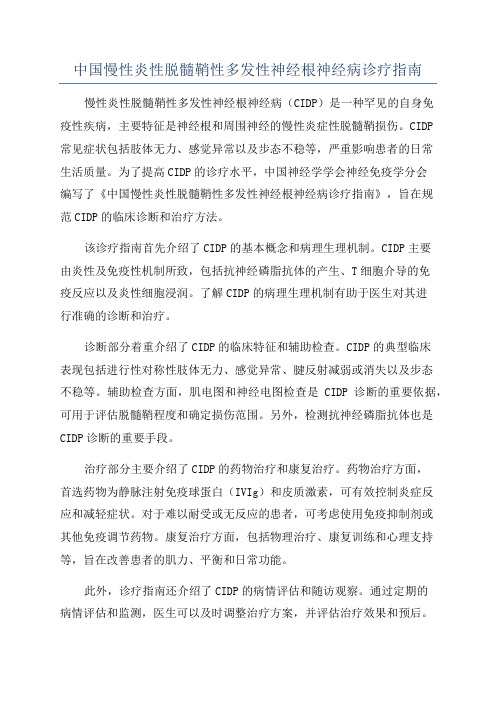
中国慢性炎性脱髓鞘性多发性神经根神经病诊疗指南慢性炎性脱髓鞘性多发性神经根神经病(CIDP)是一种罕见的自身免疫性疾病,主要特征是神经根和周围神经的慢性炎症性脱髓鞘损伤。
CIDP常见症状包括肢体无力、感觉异常以及步态不稳等,严重影响患者的日常生活质量。
为了提高CIDP的诊疗水平,中国神经学学会神经免疫学分会编写了《中国慢性炎性脱髓鞘性多发性神经根神经病诊疗指南》,旨在规范CIDP的临床诊断和治疗方法。
该诊疗指南首先介绍了CIDP的基本概念和病理生理机制。
CIDP主要由炎性及免疫性机制所致,包括抗神经磷脂抗体的产生、T细胞介导的免疫反应以及炎性细胞浸润。
了解CIDP的病理生理机制有助于医生对其进行准确的诊断和治疗。
诊断部分着重介绍了CIDP的临床特征和辅助检查。
CIDP的典型临床表现包括进行性对称性肢体无力、感觉异常、腱反射减弱或消失以及步态不稳等。
辅助检查方面,肌电图和神经电图检查是CIDP诊断的重要依据,可用于评估脱髓鞘程度和确定损伤范围。
另外,检测抗神经磷脂抗体也是CIDP诊断的重要手段。
治疗部分主要介绍了CIDP的药物治疗和康复治疗。
药物治疗方面,首选药物为静脉注射免疫球蛋白(IVIg)和皮质激素,可有效控制炎症反应和减轻症状。
对于难以耐受或无反应的患者,可考虑使用免疫抑制剂或其他免疫调节药物。
康复治疗方面,包括物理治疗、康复训练和心理支持等,旨在改善患者的肌力、平衡和日常功能。
此外,诊疗指南还介绍了CIDP的病情评估和随访观察。
通过定期的病情评估和监测,医生可以及时调整治疗方案,并评估治疗效果和预后。
在随访观察中,医生还需关注患者的药物不良反应和并发症,以保证患者的安全和治疗效果。
总之,中国慢性炎性脱髓鞘性多发性神经根神经病诊疗指南为临床医生提供了CIDP的准确诊断和有效治疗的指导,对提升CIDP的诊疗水平有着重要的意义。
同时,由于CIDP属于一种罕见病,医生还需与患者进行充分的沟通和启发,以提高患者对疾病的认知和治疗依从性。
免疫学名词解释完整版
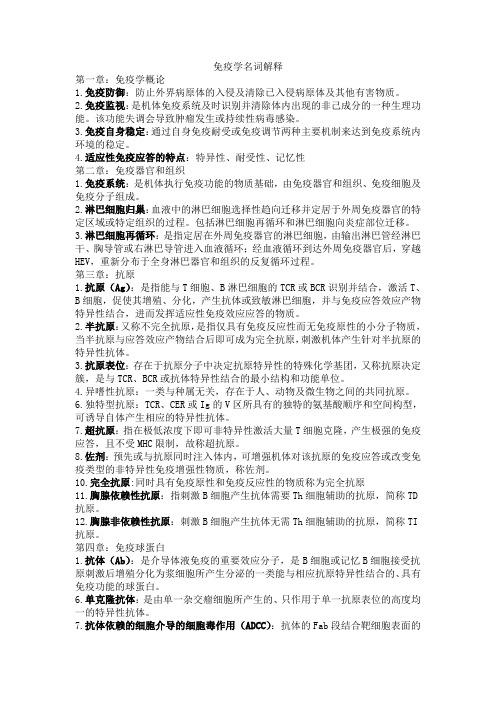
免疫学名词解释第一章:免疫学概论1.免疫防御:防止外界病原体的入侵及清除已入侵病原体及其他有害物质。
2.免疫监视:是机体免疫系统及时识别并清除体内出现的非己成分的一种生理功能。
该功能失调会导致肿瘤发生或持续性病毒感染。
3.免疫自身稳定:通过自身免疫耐受或免疫调节两种主要机制来达到免疫系统内环境的稳定。
4.适应性免疫应答的特点:特异性、耐受性、记忆性第二章:免疫器官和组织1.免疫系统:是机体执行免疫功能的物质基础,由免疫器官和组织、免疫细胞及免疫分子组成。
2.淋巴细胞归巢:血液中的淋巴细胞选择性趋向迁移并定居于外周免疫器官的特定区域或特定组织的过程。
包括淋巴细胞再循环和淋巴细胞向炎症部位迁移。
3.淋巴细胞再循环:是指定居在外周免疫器官的淋巴细胞,由输出淋巴管经淋巴干、胸导管或右淋巴导管进入血液循环;经血液循环到达外周免疫器官后,穿越HEV,重新分布于全身淋巴器官和组织的反复循环过程。
第三章:抗原1.抗原(Ag):是指能与T细胞、B淋巴细胞的TCR或BCR识别并结合,激活T、B细胞,促使其增殖、分化,产生抗体或致敏淋巴细胞,并与免疫应答效应产物特异性结合,进而发挥适应性免疫效应应答的物质。
2.半抗原:又称不完全抗原,是指仅具有免疫反应性而无免疫原性的小分子物质,当半抗原与应答效应产物结合后即可成为完全抗原,刺激机体产生针对半抗原的特异性抗体。
3.抗原表位:存在于抗原分子中决定抗原特异性的特殊化学基团,又称抗原决定簇,是与TCR、BCR或抗体特异性结合的最小结构和功能单位。
4.异嗜性抗原:一类与种属无关,存在于人、动物及微生物之间的共同抗原。
6.独特型抗原:TCR、CER或Ig的V区所具有的独特的氨基酸顺序和空间构型,可诱导自体产生相应的特异性抗体。
7.超抗原:指在极低浓度下即可非特异性激活大量T细胞克隆,产生极强的免疫应答,且不受MHC限制,故称超抗原。
8.佐剂:预先或与抗原同时注入体内,可增强机体对该抗原的免疫应答或改变免疫类型的非特异性免疫增强性物质,称佐剂。
慢性皮肤创面免疫微环境的特点及调控
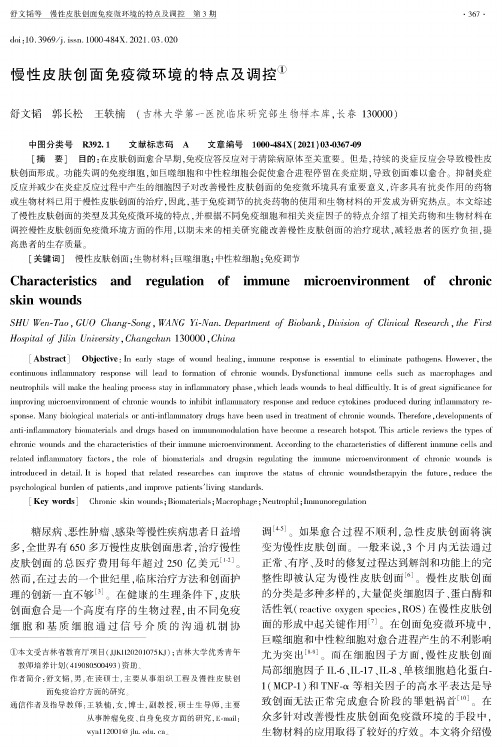
doi:10.3969/j.issn.1000484X.2021.03.020慢性皮肤创面免疫微环境的特点及调控①舒文韬郭长松王轶楠(吉林大学第一医院临床研究部生物样本库,长春130000)中图分类号R392.1文献标志码A文章编号1000-484X(2021)03-0367-09[摘要]目的:在皮肤创面愈合早期,免疫应答反应对于清除病原体至关重要。
但是,持续的炎症反应会导致慢性皮肤创面形成。
功能失调的免疫细胞,如巨噬细胞和中性粒细胞会促使愈合进程停留在炎症期,导致创面难以愈合。
抑制炎症反应并减少在炎症反应过程中产生的细胞因子对改善慢性皮肤创面的免疫微环境具有重要意义,许多具有抗炎作用的药物或生物材料已用于慢性皮肤创面的治疗,因此,基于免疫调节的抗炎药物的使用和生物材料的开发成为研究热点。
本文综述了慢性皮肤创面的类型及其免疫微环境的特点,并根据不同免疫细胞和相关炎症因子的特点介绍了相关药物和生物材料在调控慢性皮肤创面免疫微环境方面的作用,以期未来的相关研究能改善慢性皮肤创面的治疗现状,减轻患者的医疗负担,提高患者的生存质量。
[关键词]慢性皮肤创面;生物材料;巨噬细胞;中性粒细胞;免疫调节Characteristics and regulation of immune microenvironment of chronic skin woundsSHU Wen-Tao,GUO Chang-Song,WANG Yi-Nan.Department of Biobank,Division of Clinical Research,the First Hospital of Jilin University,Changchun130000,China[Abstract]Objective:In early stage of wound healing,immune response is essential to eliminate pathogens.However,the continuous inflammatory response will lead to formation of chronic wounds.Dysfunctional immune cells such as macrophages and neutrophils will make the healing process stay in inflammatory phase,which leads wounds to heal difficultly.It is of great significance for improving microenvironment of chronic wounds to inhibit inflammatory response and reduce cytokines produced during inflammatory response.Many biological materials or anti-inflammatory drugs have been used in treatment of chronic wounds.Therefore,developments of anti-inflammatory biomaterials and drugs based on immunomodulation have become a research hotspot.This article reviews the types of chronic wounds and the characteristics of their immune microenvironment.According to the characteristics of different immune cells and related inflammatory factors,the role of biomaterials and drugsin regulating the immune microenvironment of chronic wounds is introduced in detail.It is hoped that related researches can improve the status of chronic woundstherapyin the future,reduce the psychological burden of patients,and improve patients'living standards.[Key words]Chronic skin wounds;Biomaterials;Macrophage;Neutrophil;Immunoregulation糖尿病、恶性肿瘤、感染等慢性疾病患者日益增多,全世界有650多万慢性皮肤创面患者,治疗慢性皮肤创面的总医疗费用每年超过250亿美元[1-2]。
免疫细胞介导的炎症反应和炎症相关疾病

免疫细胞介导的炎症反应和炎症相关疾病人体内存在着许多免疫细胞,它们能够通过不同的方式来保卫人体免受外来病原体的侵袭。
其中,免疫细胞介导的炎症反应是一种常见的免疫机制,当人体受到伤害或感染时,免疫细胞会释放一系列细胞因子,导致炎症反应的发生。
虽然炎症反应是一种正常的生理反应,但它在某些情况下也会导致炎症相关疾病的发生。
一、免疫细胞介导的炎症反应炎症反应是一种复杂的生理反应,它由多种免疫细胞及其释放的细胞因子协同作用而实现。
通常,当身体受到伤害或感染时,免疫细胞会释放一系列细胞因子和化学物质,如肿瘤坏死因子、白细胞介素、前列腺素和白三烯等,导致炎症反应的发生。
炎症反应分为两个阶段:早期和晚期炎症反应。
早期炎症反应主要由中性粒细胞和单核细胞介导,它们是第一时间到达受伤或感染部位的免疫细胞。
中性粒细胞和单核细胞能够发挥自身的吞噬和杀伤作用,同时还会分泌多种细胞因子,导致局部炎症反应的发生。
晚期炎症反应则由T细胞和B细胞介导,它们能够识别并攻击感染的病原体,在发挥杀伤作用的同时,也会释放多种细胞因子,加剧炎症反应的程度。
二、炎症相关疾病尽管炎症反应是一种正常的生理反应,但在某些情况下也会导致炎症相关疾病的发生。
常见的炎症相关疾病包括:1.类风湿性关节炎类风湿性关节炎(rheumatoid arthritis,RA)是一种以关节炎为主要表现的自身免疫性疾病。
它的病因尚不清楚,但与免疫细胞介导的炎症反应有关。
所有类风湿性关节炎患者都存在关节突出(pannus)的形成,这是一种由T细胞和B细胞介导的炎症反应,导致局部关节滑膜的渗出和破坏。
2.炎症性肠病炎症性肠病(inflammatory bowel disease,IBD)是一组以肠道炎症为主要表现的疾病,包括溃疡性结肠炎和克罗恩病。
炎症性肠病的病因尚不清楚,但与免疫细胞介导的炎症反应有关。
在炎症性肠病患者中,免疫细胞会攻击肠道内的正常细胞和细菌,导致肠黏膜受损和炎症反应。
病理学中的免疫性疾病与病变特点

病理学中的免疫性疾病与病变特点免疫性疾病是指机体免疫系统发生异常反应,攻击正常组织或物质而导致的疾病。
这类疾病在病理学上有着独特的病变特点,本文将对其病理改变进行探讨。
一、自身抗体介导的病变大多数免疫性疾病是由自身产生的抗体介导引起的。
包括类风湿关节炎、系统性红斑狼疮、硬皮病等。
其病理特点是炎性细胞浸润、组织坏死和纤维化增生等。
以类风湿关节炎为例,其关节软骨和韧带边缘处有严重的滑膜炎和滑膜细胞增生。
软骨下骨板变薄,软骨下骨质疏松。
同时,关节囊增厚,内膜面增生,产生大量滑液。
大量炎性渗出物积聚在关节囊腔内,引起关节积液。
二、细胞毒性T淋巴细胞介导的病变包括多发性硬化、视神经脊髓炎等。
这类疾病的病理特点是神经髓鞘被毁、组织脱髓鞘和旁突破坏。
以多发性硬化为例,病变处的神经髓鞘破坏,使得神经冲动的传导速度减慢,最后逐渐出现轻重不同的神经缺损症状。
三、抗体介导的免疫复合物病变包括系统性红斑狼疮、感染性心内膜炎等。
这类疾病的病理特点是大量免疫复合物沉积在组织、器官中,引起明显炎症反应和组织损伤。
以系统性红斑狼疮为例,病变处肾小球毛细血管被免疫复合物堵塞,引起大量炎症介质释放,导致局部血管炎症反应进一步加重。
同时,机体免疫系统针对自身细胞抗原产生大量自身抗体,进一步诱导免疫细胞浸润,形成细胞和免疫复合物联合损伤,加重炎症损伤。
四、细胞介导的细胞毒性作用包括溶血性贫血、自身免疫性甲状腺炎等。
这类疾病的病理特点是由细胞介导的细胞毒性作用导致组织、器官受损。
以溶血性贫血为例,机体免疫系统异常激活,产生与红细胞膜抗原相应的抗体,其中IgG型抗体最常见。
IgG型抗体和红细胞表面相应抗原结合,激活补体,引起细胞毒性反应,致使红细胞溶解,导致溶血性贫血。
总之,免疫性疾病是由机体免疫系统异常激活而引起的疾病,在病理学上具有独特的病变特点。
不同类型的免疫性疾病病理变化不同,包括自身抗体介导的病变、细胞毒性T淋巴细胞介导的病变、抗体介导的免疫复合物病变和细胞介导的细胞毒性作用等。
自身免疫病诊疗规范2023版

自身免疫病诊疗规范2023版自身免疫病(autoimmunedisease)是指以自身免疫应答反应导致组织器官损伤和相应功能障碍为主要发病机制的一类疾病,它的确切病因目前还不十分清楚。
现代的自身免疫病的病因已经基本明确是宿主遗传倾向性与环境因素共同作用的结果。
近年的研究表明一部分非经典的自身免疫病或自身免疫样表现的疾病与宿主的基因突变有关。
机体免疫系统具有识别“自己”与“非己”抗原物质的能力,在正常情况下,免疫系统对自身组织抗原不产生或只产生极微弱的免疫应答反应,这种现象称为自身耐受。
自身耐受是由免疫系统通过多种机制主动调节来维持的,借以保证自身组织细胞成分不致遭受免疫反应的攻击而造成损伤。
在某些情况下,自身耐受性遭受破坏,免疫系统对自身组织成分产生了明显的免疫应答反应,即在体内产生了针对自身组织成分的抗体或致敏淋巴细胞,称为自身免疫。
自身免疫在许多情况下是属于生理性的,因为在一定限度内的自身免疫应答反应有助于清除体内衰老退变或畸变的自身细胞成分,并且对免疫应答反应起着调节作用。
只是在自身免疫应答反应超越了生理的限度或持续时间过久,才会造成自身组织损伤和相应的功能障碍,导致疾病的发生。
自身免疫病的发病率还不十分清楚,常见的24种自身免疫病在美国的发病率约为1/31,其中最常见的是毒性甲状腺肿,发病率为115.1/10000。
目前已被公认的自身免疫病至少有30多种,涉及各个不同系统或组织的疾病(详见各有关章节,表21-8-0-1列举一些实例)。
根据自身免疫反应对组织器官造成损伤的范围,通常将自身免疫病划分为“器官特异性”和“非器官特异性”(全身性)两大类(表21-8-0-2)。
但这种区分并不是十分严格的,因为在某些“器官特异性”自身免疫病患者的血清学检查时常可发现交叉重叠现象,如自身免疫性甲状腺炎患者的血清中除可检出抗甲状腺球蛋白和抗甲状腺微粒体的自身抗体外,有时还可检出抗胃黏膜抗体、抗核抗体和类风湿因子等。
自身耐受和免疫异常与免疫介导的炎症性疾病
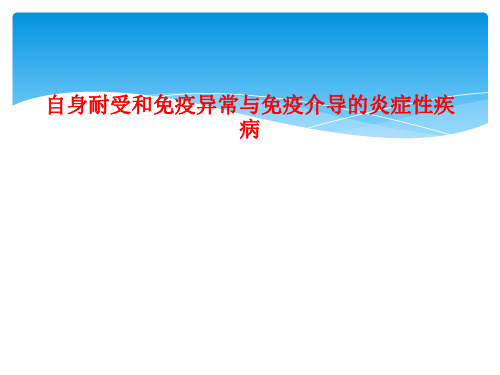
Induced Treg (iTreg) Th3
Periphery (MALT) CD4+CD25+ from
CD25- precursors CD25low-
variableCD45RBlowF oxp3+
TGF beta mediated
Unknown
CD28 Involvement
in vivo Role
analysis
• Some polymorphisms are associated with multiple diseases
– May control general mechanisms of tolerance and immune regulation
• Other genetic associations are diseasespecific
From Abbas and Lichtman. Basic Immunology 2nd ed, 2006
Both pathways cooperate to prevent reactions against self
Regulatory T cells
From Abbas, Lichtman and Pillai. Cellular and Molecular Immunology 6th ed, 2007
Inflammatory disease, e.g. reactions against self
No response to self Controlled response to
pathogens
免疫调节的重要性
• 避免正常抗感染免疫应答过程中出现过量淋巴 细胞活化造成组织损伤。
- 1、下载文档前请自行甄别文档内容的完整性,平台不提供额外的编辑、内容补充、找答案等附加服务。
- 2、"仅部分预览"的文档,不可在线预览部分如存在完整性等问题,可反馈申请退款(可完整预览的文档不适用该条件!)。
- 3、如文档侵犯您的权益,请联系客服反馈,我们会尽快为您处理(人工客服工作时间:9:00-18:30)。
自身免疫
• 自身免疫与自身免疫病: 自身免疫:抗自身抗原的免疫应答。 自身免疫病:自身免疫应答对机体造成病理 性损伤。此种疾病通常被分类为“免疫介导的炎 症性疾病”。 • 总体特点: –发生机制: 易感基因 + 环境诱发 –全身性和器官特异性
Central and peripheral tolerance
Immune responses against self tissues
Genetics of autoimmunity
• Human autoimmune diseases are complex polygenic traits
– Identified by genome-wide association mapping – Single gene mutations are useful for pathway analysis
Pathogenesis of autoimmunity
Susceptibility genes Failure of self-tolerance Persistence of functional self-reactive lymphocytes Activation of self-reactive lymphocytes Environmental trigger (e.g. infections, tissue injury)
• What factors determine the balance of effector cells and Treg?
Signals for the generation and maintenance of regulatory T cells
• Antigen recognition, with or without inflammation? • TGF- (source?) • Interleukin-2 (originally identified as T cell growth factor; major function is to control immune responses by maintaining functional Treg; works via Stat5) • Low levels of B7: CD28 costimulation • Transcription factor Foxp3
Immune-mediated inflammatory diseases
• Chronic diseases with prominent inflammation, often caused by failure of tolerance or regulation
– RA, IBD, MS, psoriasis, many others – Affect 2-5% of people, incidence increasing
自身耐受和免疫调节异 常与免疫介导的炎症性 疾病
吕昌龙 中国医科大学免疫研究所
Balancing lymphocyte activation and control
Activation Effector T cells Tolerance Regulatory T cells
Normal: reactions against pathogens Inflammatory disease, e.g. reactions against self
From Abbas and Lichtman. Basic Immunology 2nd ed, 2006
Both pathways cooperate to prevent reactions against self
Regulatory T cells
From Abbas, Lichtman and Pillai. Cellular and Molecular Immunology 6th ed, 2007
Apoptosis (activation-induced cell death)
Suppression
APC
Block in activation
Regulatory T cell
T cell anergy
“Activation-induced cell death”: death of mature T cells upon recognition of self antigens
– May influence end-organ damage
Genetics of autoimmunity: recent successes of genomics
• NOD2: polymorphism associated with ~25% of Crohn’s disease • PTPN22: commonest autoimmunityassociated gene; polymorphism in RA, SLE, others
Target Cells CD28 Involvement in vivo Role
Effector T Cells Unnecessary for development or function Mucosal immunity, inflammatory response CD3, IL-10, Retinoic Acid
The principal fate of lymphocytes that recognize self antigens in the generative organs is death (deletion), BUT: Some B cells may change their specificity (called “receptor editing”) Some CD4 T cells may differentiate into regulatory (suppressive) T lymphocytes
Induced Treg (iTreg) Tr1
Periphery (MALT) CD4+CD25CD45RBlowFoxp3-
Induced Treg (iTreg) Th3
Periphery (MALT) CD4+CD25+ from CD25- precursors CD25lowvariableCD45RBlow F
From Abbas, Lichtman and Pillai. Cellular and Molecular Immunology 6th ed, 2007
Consequences of self antigen recognition in thymus
From: Abbas & Lichtman, Cellular & Molecular Immunology 5th ed 2003
– Many activated T cells (not only Treg) may transiently express Foxp3
cellular therapy with Regulatory T cells? • Some autoimmune diseases are associated with defective generation or function of Tregs or resistance of effector cells to suppression by Tregs • Will cellular therapy with ex vivo expanded Treg become a reality? Therapeutic goal: selective induction or activation of Treg in immune diseases
Unknown Unnecessary for development or function Mucosal immunity, inflammatory response CD3, TGF beta
in vitro Expansion
Peripheral (adaptive, inducible) regulatory T cells
• CD25 (IL-2R): associated with MS, others; genome-wide association mapping
• Develop from mature CD4 T cells that are exposed to persistent antigen in the periphery • May be generated in all immune responses, to limit collateral damage • Can be induced in vitro (stimulation of CD4 T-cells in presence of TGF + IL-2)
Peripheral tolerance
Normal T cell response
CD28 APC TCR
T cell
Activated T cells
Anergy
APCBiblioteka TCROff signals
Functional unresponsiveness
Deletion
APC
Activated T cell
• May result from immune responses against self antigens (autoimmunity) or microbial antigens (Crohn’s disease?)
• May be caused by T cells and antibodies • May be systemic or organ-specific
